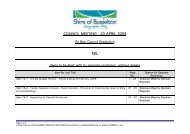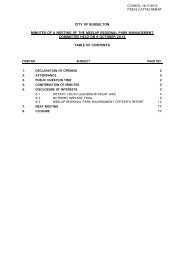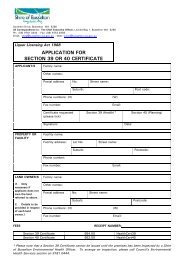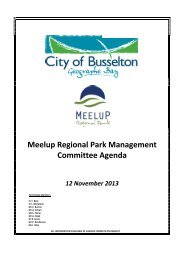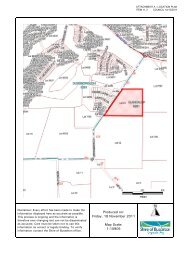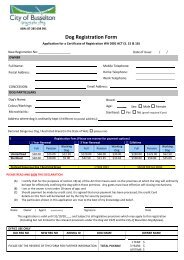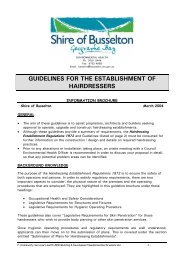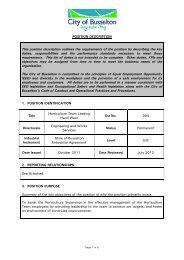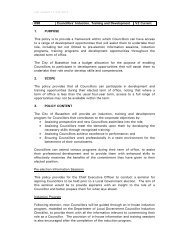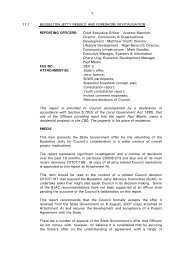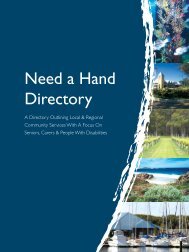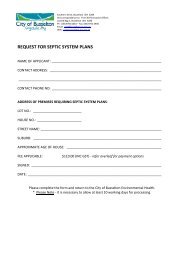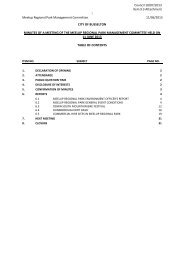NatureVerge - Shire of Busselton
NatureVerge - Shire of Busselton
NatureVerge - Shire of Busselton
You also want an ePaper? Increase the reach of your titles
YUMPU automatically turns print PDFs into web optimized ePapers that Google loves.
<strong>NatureVerge</strong><br />
VERGE LANDSCAPING WITH A DIFFERENCE!
<strong>NatureVerge</strong><br />
VERGE LANDSCAPING WITH A DIFFERENCE!<br />
This guide is intended to provide assistance in waterwise verge design for <strong>Shire</strong> <strong>of</strong> <strong>Busselton</strong> residents. Street<br />
verges account for a surprisingly large amount <strong>of</strong> land within the <strong>Shire</strong> <strong>of</strong> <strong>Busselton</strong> and allow room for public<br />
services such as water and power, as well as increasing public space and visually linking a streetscape.<br />
Many <strong>of</strong> the <strong>Shire</strong>’s verges are irrigated lawn, which require significant maintenance and use large amounts<br />
<strong>of</strong> water and fertiliser. In a drying climate, it is important now more than ever to identify ways in which we<br />
can reduce our water use, and replacing large areas <strong>of</strong> lawn with mulch and native plant species is a simple<br />
solution. Over-applied fertilisers also impact on our environment, with nutrients running <strong>of</strong>f into stormwater<br />
drains, ending up in our rivers, wetlands and eventually into Geographe Bay.<br />
You can make a positive difference to the environment with your verge, with a landscaping design that is<br />
waterwise, beautiful and reflects the natural heritage <strong>of</strong> the town. It can also save you time and money!<br />
Who’s responsible for the verge?<br />
The <strong>Shire</strong> is responsible for street trees and enforcing verge requirements in the case <strong>of</strong> hazardous or<br />
unsuitable installations, but maintenance <strong>of</strong> the verge is the householders’ responsibility. You therefore have<br />
the choice <strong>of</strong> what to do with your verge, provided it meets the <strong>Shire</strong>’s requirements.<br />
Why choose local native plants?<br />
Local native plants and wildflowers are not only beautiful; they have a range <strong>of</strong> other benefits:<br />
• The wildflowers, shrubs and trees <strong>of</strong> the <strong>Shire</strong> <strong>of</strong> <strong>Busselton</strong> are suited to the local soils and climate conditions.<br />
• Local native plants support the range <strong>of</strong> living things (or biodiversity) within our area.They provide shelter<br />
and food for birds, butterflies, insects, frogs and mammals, and provide corridors <strong>of</strong> movement between<br />
areas <strong>of</strong> bushland.<br />
• Local native plants are easier to care for than introduced plants. They require less fertiliser, water and<br />
pruning than introduced plants, so they can save you time and money and leave you more time to enjoy<br />
your garden.<br />
• Most <strong>of</strong> the weeds existing in our environment today originated from gardens. Planting local native plants<br />
eliminates the risk <strong>of</strong> weeds ending up in our bushland.<br />
• Local native plants help develop and maintain the unique natural character that is strongly valued in the<br />
<strong>Shire</strong> <strong>of</strong> <strong>Busselton</strong>.<br />
Did you know that the <strong>Shire</strong> can provide free <strong>of</strong> charge 2 street trees for an average 20<br />
metre verge frontage, four trees for a corner block and a maximum <strong>of</strong> six trees for a special rural<br />
or industrial area block (For full conditions see the <strong>Shire</strong>’s Technical Specifications, Section 9c).
Species list<br />
The <strong>Shire</strong> <strong>of</strong> <strong>Busselton</strong> encourages the use <strong>of</strong> the following local native plant species. Other plants may be used as<br />
long as they meet with the <strong>Shire</strong>’s requirements, are waterwise and are not considered as environmental weeds.<br />
Species<br />
Trees<br />
Flowers Colour Soil Notes<br />
Agonis flexuosa<br />
(WA peppermint)<br />
Oct/Dec White Sand/gravel 6-8 m, Ringtail possum habitat<br />
Corymbia ficifolia<br />
(red flowering gum)<br />
Dec/May Red/orange Sand/loam/gravel 5-8 m, prefers some protection<br />
Eucalyptus caesia<br />
May/Sep Pink/red Sand/<br />
2-6 m, pendulous branches<br />
(silver princess)<br />
loam/granite<br />
Melaleuca lanceolata<br />
Jan/Sep White Sand/limestone 2-8 m, tolerates salt and wind,<br />
(Rottnest ti-tree)<br />
interesting shapes<br />
Melaleuca preissiana<br />
(moonah)<br />
Nov - Jan Cream/ white Sand/swamps 2-9 metres<br />
Melaleuca viminea<br />
(mohan)<br />
Shrubs<br />
Jul/Nov Cream/ white Sand/clay 1-5 m, suitable for smaller areas<br />
Billardiera fusiformis (Australian All year Blue Variable Delicate hanging flowers. Twining<br />
bluebell)<br />
shrub<br />
Calothamnus sanguineus Mar-Jul Red Sand/gravel One sided bottlebrush like flowers,<br />
(silky-leaved bloodflower)<br />
pine like foliage<br />
Calytrix flavescens (summer<br />
starflower)<br />
Dec-Jan Yellow Sand Delicate shrub grows to 50cm<br />
Dampiera linearis (common<br />
Dampiera)<br />
Aug-Dec Blue Sand/gravel Lovely, brilliant blue flowers<br />
Darwinia citriodora<br />
(lemon-scented Darwinia)<br />
Aug-Oct Red/orange Gravel/granite Widely cultivated, perfumed foliage
Species list continued...<br />
Species Flowers Colour Soil Notes<br />
Eromophila glabra spp Various Various Various Variable species with tube like flowers<br />
Frankenia pauciflora (sea heath) Jan-Feb Pink/white Sand Hardy plant<br />
Hypocalymma angustifolium<br />
Jun-Oct White/cream Sand/clay/near watercourses Delicate foliage with stems covered<br />
(white myrtle)<br />
in flower<br />
Hypocalymma robustum Jun-Nov Pink/red Sand/gravel One <strong>of</strong> our most vibrant spring<br />
(Swan River myrtle)<br />
wildflowers<br />
Leucophyta brownii (cushion bush) Dec-Feb Yellow Sand Silvery-grey foliage, good border plant<br />
Melaleuca trichophylla Aug-Dec Pink/purple Sand/gravel Vibrant cotton ball-like flowers<br />
Pimelea ferruginea<br />
Strap-leaved shrubs<br />
Aug-Feb Pink Sand/limestone/granite Cushion-like habit<br />
Conostylis aculeata (prickly conostylis) Aug-Nov Yellow Variable Small plant with multiple flower heads<br />
Conostylis candicans (grey<br />
cottonhead)<br />
Sept-Oct Yellow Sand/limestone Compact<br />
Ficinia nodosa<br />
Oct-Jan Brown/cream Sand/granite/ limestone/ Common along the coast, reed like<br />
(knotted club rush)<br />
seasonal wetlands foliage<br />
Anigozanthos flavidus (tall kangaroo<br />
paw)<br />
Nov-Jan Green/red Sand/clay/gravel Flowers can grow to 2m tall<br />
Dianella brevicaulis Oct-Dec Blue/purple Sand/clay Distinctive foliage<br />
Patersonia occidentalis (purple flag)<br />
Groundcover<br />
Aug-Jan Purple Various Large open petals on long stems<br />
Carpobrotus virescens (pigface) Sept-Jan Purple Coastal Succulent creeper grey-green leaves.<br />
Hardenbergia comptoniana<br />
(native wisteria)<br />
Jul-Oct Blue Sand Produces wonderful displays<br />
Kennedia coccinea (coral vine) Sep-Nov Red Sand Brilliant red flowers
Process<br />
Installing verge plantings <strong>of</strong> any type (except for lawn) requires permission from the <strong>Shire</strong> so that we<br />
can ensure that designs are not hazardous and do not interfere with pedestrian safety or motorists line<strong>of</strong>-sight.<br />
Please submit the attached verge installation form prior to undertaking any works. Officers are<br />
available for assistance and there is no submission fee.<br />
Complete verge installation form.<br />
<br />
Submit to <strong>Shire</strong> <strong>of</strong> <strong>Busselton</strong>.<br />
<br />
The <strong>Shire</strong> will assess your application and make any amendments necessary to ensure the plan<br />
conforms to the <strong>Shire</strong>’s requirements.<br />
<br />
The landscaping plan will be returned to you, along with a letter <strong>of</strong> approval and any<br />
conditions that may apply.<br />
What are the <strong>Shire</strong>’s requirements?<br />
• The verge landscaping must be waterwise and use species that are not considered environmental<br />
weeds.The <strong>Shire</strong> encourages the use <strong>of</strong> local native plants (have a look at our species list).<br />
• Plants to be less than 75cm at maturity (excluding street trees) and not contain sharp edges or<br />
poisonous properties.<br />
• Trees to be selected only from the approved tree list.<br />
• Pavers (max 25% <strong>of</strong> area) must be pr<strong>of</strong>essionally laid, with no trip points, non slip and bedded flush<br />
with surrounding infrastructure (<strong>Shire</strong> preference is for red clay pavers).<br />
• Planting is not to interfere with vehicle or pedestrian sight lines.<br />
• No loose stone aggregates.<br />
• Pedestrians to have easily managed access path through verge (parallel to road) by existing footpath<br />
or allowance for access footpath at a minimum 2 metres width from back <strong>of</strong> kerb.<br />
• All reticulation, if necessary, to be set at ground level height.<br />
• Mulch to be contained within designated area.<br />
• Flush ground levels are to be retained with surrounding infrastructure.<br />
• Trees to be 2.5 metres <strong>of</strong>f property boundary (service corridor), 1 metre minimum away from any<br />
underground service or dual use path and 2.5 metres from other infrastructure including crossovers,<br />
inspection pits etc.
Driveway<br />
Driveway<br />
Footpath<br />
Footpath<br />
Footpath<br />
Footpath<br />
Driveway<br />
Driveway<br />
Landscape designs<br />
To the left are some suggested<br />
landscape designs, however<br />
you can be creative in your<br />
design (as long as it meets<br />
the <strong>Shire</strong>’s requirements).<br />
Courtesy <strong>of</strong> Lynne Boladeras.<br />
Key<br />
Bins<br />
Existing tree<br />
(or new planting)<br />
Mulch<br />
Strappy plants<br />
Shrubs
Planting out<br />
• Lay plants out in pots exactly where you want to plant them. Keep in mind the size and shape the<br />
plants will become.<br />
• Dig a bowl-shaped hole twice as wide and slightly deeper than the pot. Loosen soil in and around the<br />
hole so the roots will have an open, light soil to grow into.<br />
• Thoroughly water the plant, hole and surrounding soil before planting.<br />
• Remove the plant from the pot. If the plant is root-bound, make a few vertical cuts through the root<br />
ball with secateurs.<br />
• Place the plant in the centre <strong>of</strong> hole and backfill with surrounding moist soil. Press the soil in gently<br />
and firmly to remove air pockets. Place plant deep enough to form a shallow depression around it.<br />
This will protect the plant from drying out by directing water towards the roots.<br />
• Spread a layer <strong>of</strong> suitable mulch.<br />
Mulch<br />
• The best type <strong>of</strong> mulch is coarse organic material eg. natural leaf litter or street tree loppings, as it lets<br />
water easily penetrate through to the soil and prevents evaporation.<br />
• Lay a depth <strong>of</strong> 5-10cm to prevent weed establishment but still allowing water to penetrate.<br />
• Avoid mulching too close to the plant stem, as the constant humidity encourages plant diseases.<br />
• Organic mulches need renewing seasonally as they break down over time.They are best applied in<br />
spring and early summer.<br />
• Avoid some packaged mulches as they contain high levels <strong>of</strong> nitrogen and phosphorus which aren’t<br />
suitable for WA plants.
Watering<br />
• Local plants are adapted to our dry climate and low rainfall and need some stress to perform<br />
their best.<br />
• Overwatering leads to shorter lived plants with excessive growth and less prolific flowering.<br />
• Overwatering can also encourage diseases that lead to root rot, as well as leaching nutrients out <strong>of</strong><br />
the soil.<br />
• The best irrigation to use is adjustable dripper/trickle systems or subsurface irrigation. This reduces<br />
evaporation loss and prevents overwatering.<br />
• For new plants water:<br />
- once or twice a week in the first few weeks after planting.<br />
- once or twice a week in the summer period for the first 1-2 years until plants are established.<br />
• For established plants, only water when there is a heat wave, when subsurface soil is dry or when signs<br />
<strong>of</strong> stress are apparent.<br />
• Always follow water restrictions. Check out www.watercorporation.com.au for information on your<br />
sprinkler roster.<br />
Fertilisers<br />
• Our local native plants are adapted to soils that are low in nutrients, so generally do not require<br />
fertiliser.<br />
• If you do wish to apply fertiliser, slow-release, low phosphorus fertilisers are the best to use.
✁<br />
Nature Verge Installation Form<br />
I, (name <strong>of</strong> applicant) .............................................................................................................................................................................<br />
request permission to install landscaping treatment on the verge adjacent to<br />
(property address) .................................................................................................................................................................................<br />
During installation and upon completion <strong>of</strong> the work I agree to maintain the verge installation<br />
so as not to cause a hazard, including watering and maintaining any overflow on site.<br />
Applicant signature: .....................................................................................................................................................................<br />
Date: .....................................................................................................................................................................................................<br />
Contact details:<br />
Postal Address (if different from above)<br />
..................................................................................................................................................................................................................<br />
..................................................................................................................................................................................................................<br />
Phone number: ..............................................................................................................................................................................<br />
Please show dimensions <strong>of</strong> the area to be landscaped, approximate position <strong>of</strong> the proposed<br />
plants, the type and layout <strong>of</strong> reticulation (if any) and paving noting any existing features<br />
(services, crossover, street tree, footpath, bin space etc) on landscape sketch overleaf. Please<br />
attach proposed species list (including locality and height at maturity if not from the approved<br />
species list).<br />
<strong>Shire</strong> Officer to complete<br />
Permission is given for the verge proposal as in this submitted sketch to be installed.<br />
Signature <strong>Shire</strong> Officer<br />
............................................................................................................................................................................................................<br />
PTO
Your Landscape Sketch<br />
✁
Find out more<br />
Geographe Community Landcare Nursery website for local species and projects<br />
http://geographelandcarenursery.mysouthwest.com.au/<br />
Water Corporation website for waterwise gardening<br />
www.watercorporation.com.au/<br />
Sustainable Gardening Australia website<br />
www.sgaonline.org.au/<br />
FloraBase website<br />
http://florabase.dec.wa.gov.au/<br />
Great Gardens workshops<br />
www.greatgardens.info<br />
Growing Locals by Powell, R. & Emberson, J. (1996).WA Naturalist’s Club, Perth.<br />
Growing Local Native Plants in <strong>Busselton</strong> Urban Areas – a Guide by the<br />
<strong>Busselton</strong>-Dunsborough Environment Centre and GeoCatch (2007).<br />
Field Guide to the Wildflowers <strong>of</strong> Australia’s South West by Scott, J. & Negus, P. (2002).<br />
Cape to Cape Publishing, North Fremantle.<br />
Participating nurseries<br />
Geographe Community Landcare Nursery<br />
366 Queen Elizabeth Avenue<br />
Phone: 9754 2049<br />
http://geographelandcarenursery.mysouthwest.com.au<br />
Anniebrook Plants & Design<br />
Location 1710 Caves Rd, Dunsborough<br />
Phone: 9755 3705<br />
Newtown Nursery<br />
Bussell Highway, Vasse<br />
Phone: 9755 4955<br />
The Native Nursery<br />
(By appointment only) <strong>Busselton</strong><br />
Phone: 9751 1427<br />
Bunnings<br />
Cnr Strelly Street and <strong>Busselton</strong> Bypass, <strong>Busselton</strong><br />
Phone: 9752 6100<br />
Mitre 10<br />
West Street, <strong>Busselton</strong><br />
Phone: 9752 4022<br />
The <strong>Shire</strong> <strong>of</strong> <strong>Busselton</strong>’s demonstration verges are located opposite the <strong>Shire</strong>’s Offices<br />
on Southern Drive and on Strelly Street in the Light Industrial Area.<br />
Flora photos courtesy <strong>of</strong> Martin Pritchard, Katie Biggs and Richard Clark.
Proudly supported by<br />
Southern Drive <strong>Busselton</strong> Western Australia<br />
Tel: (08) 9781 0444<br />
Fax: (08) 9752 4958<br />
shire@busselton.wa.gov.au<br />
www.busselton.wa.gov.au<br />
Office hours: Monday to Friday 8.30am to 4.30pm<br />
All communications to The Chief Executive Officer<br />
Locked Bag 1 <strong>Busselton</strong> WA 6280<br />
This publication has been printed on 100% recycled paper with vegetable based ink.



